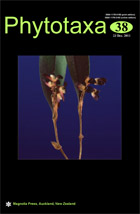Abstract
Macro- and micro-morphological characters, molecular nuclear ribosomal internal transcribed spacer and chloroplast trnL-F intron-spacer data confirmed the hybrid status of Oreocharis × heterandra. Cytological studies showed that the parental species and the hybrid possess 2n=34 chromosomes, suggesting that chromosome translocations, not dysploid or ploidy level changes, are the cause of the high hybrid sterility. Recurrent reciprocal hybridisation between its parental species O. argyreia and O. magnidens in an area of secondary contact is apparently responsible for the persistent presence of the hybrids, though at low levels. As a consequence the name Oreocharis heterandra has to be changed to Oreocharis × heterandra.

